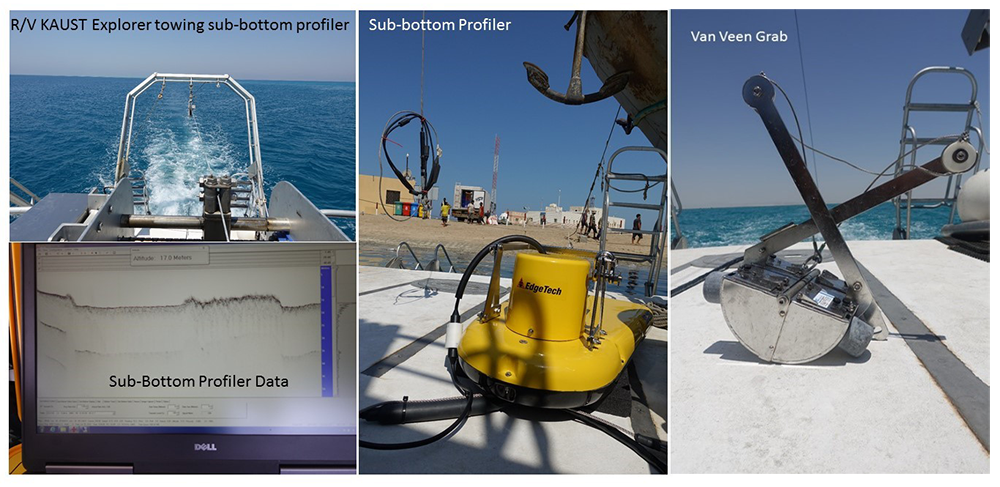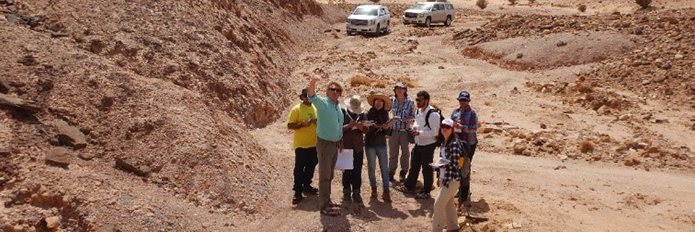.jpg?sfvrsn=39330263_0)
.jpg?sfvrsn=39330263_0)

04 October, 2018
The Carbonate Reservoirs Group (CaResS) provides tools and insights to the industry to improve the efficiency of hydrocarbon recovery from carbonate reservoirs, increasing the overall recovery factor while lowering development costs. We create and evaluate high resolution static and dynamic reservoir models under different recovery scenarios. These models rely on multi-scale property heterogeneities typically found in Jurassic, Cretaceous and Cenozoic carbonate reservoirs of Arabia. To understand these depositional, diagenetic and structural heterogeneities, our group has launched a series of extensive field work campaigns collecting age and location specific data.
Jurassic Reservoir Analogues, Tuwaiq Mountain Escarpment
In Q1 2018 CaResS launched scouting and initial data collection for two projects on Jurassic carbonates in the Tuwaiq Mountain escarpment, south of Riyadh.
The first project focuses on the Jubaila Formation in the Diplomatic Quarter area of Riyadh, part of the Late Jurassic Arab D reservoir sequence which contains several super giant oil fields to the east. Oil is commonly left behind in the lower portions of Jurassic and Cretaceous reservoirs in Arabia due to flood front overruns which are caused by a succession from high to low vertical permeability. The exposed section forms the low-permeability lower part which is overlain by high-permeability sediments of the Arab D Formation proper.
During the first field campaign in January CaResS collected two seismic lines, a depositional profile and fracture data, which supplement laboratory data on porosity, permeability, and pore network visualization derived from a core ANPERC collected in 2017. Together these data provide greater understanding of: the depositional environment, fracture frequency and orientation with respect to regional structural elements, and the recognition of channel and isolated reefs using shallow seismology. Follow-up campaigns are planned for Q1 2019.


A second project aims at improving the understanding of depositional heterogeneities in the upper part of typical depositional cycles that result in bypassed oil. Uneven recovery fronts happen because here sediments are grain-rich, and interbedded with reefs and reef debris, leading to high porosity/permeability and large horizontal property heterogeneities. Initial scouting revealed high quality outcrops in Wadi Birk and other areas close to the town of Howtat Bani Tamim some 200 km. An initial survey for drone-based high resolution photogrammetry was conducted together with FalconViz improving logistics and workflow in preparation for a larger campaign planned for Q1 2019. According to postdoctoral fellow Pankaj Khanna "These maps are crucial as they will serve as base maps for the project, and will also provide a magnified view helping to map beds and structures."
Rift Basin Carbonates
In July 2018, together with researchers from the Santamarina research group (EGEL), CaResS conducted a two week reconnaissance research trip to Al Wahj Lagoon and adjacent coastal areas along the Red Sea, including offshore and onshore field work. Pankaj Khanna: [This area] "represents a natural laboratory to study rift-setting shallow water carbonates."
Offshore, the KAUST Explorer research vessel collected sub-bottom geophysical profiles and sediment grab samples from the southern part of Al-Wahj lagoon in water depth of 3m - 40 m. The sub-bottom profiler is a tool to peak into the subsurface sediments that have been deposited on the ocean floor since the Pleistocene. The raw sub-bottom profiles displayed variation in thickness of the topmost soft sediment layer, as well as places where the ocean floor is cemented or covered by corals. The Van Veen grab tool was used to sample the topmost sediments lying on the sea-floor. Compositional analysis of sediment samples will be combined with the geophysical profiles, environmental data (water depth, temperature, salinity and currents from ground surveys) and high resolution satellite images. Mapping the thickness and composition of Holocene sediments deposited in the Al Wahj Lagoon will reveal the architecture and compositional make-up of ancient rift-basin carbonate platforms.


Onshore field work included mapping and sampling loose sediments, and drilling exposed reefs along the coastline using new hand-held drill machines. Mapping the sediments reveals that sea-level was potentially a few meters higher at Al-Wahj during the recent past, raising questions on the precision of existing sea level curves and tectonism in the region.


The Red Sea Development Project, a new mega project developing tourism and bringing jobs to Saudi Arabia, is also active in the area. CaResS has developed excellent relationships and agreed to data exchange with several companies doing environmental and geotechnical work in support of this project.
Field Excursions in Support of Teaching
A systematically designed syllabus of eight field trips supplements classroom teaching by giving students firsthand impressions of the carbonate geological system that comprises the vast majority of hydrocarbon reservoirs in Arabia supplement classroom teaching. Advanced aspects of the genesis of carbonate sediments include the lateral and vertical arrangements of sediment successions that lead to the vast carbonate rock sequences of Arabia. Typically two or three dedicated instructors and guest lecturers provide groups of up to 18 students with a hands-on and immersive learning experience. Feeling, smelling, touching and observing carbonates as they are being created gives students a better understanding of ancient carbonate sequences. Last year CaResS took advantage of KAUST's strategic location amid natural laboratories to conduct five trips:


Littoral sediments and carbonate components (a 3 hours walking trip at KAUST Beach).


Reef and back-reef sediments (a 1 day snorkeling trip to the Red Sea reefs in front of KAUST).


Modern carbonate sediments of Abu Dhabi (a 2 1/2 day trip to the ooid shoals, lagoons and sabkhas of the Arabian Gulf).


The Jurassic sequences of Central Saudi Arabia (a 5 day trip to the spectacular outcrops of the Tuwaiq Mountain escarpment south of Riyadh).


The Cretaceous Sequences of the giant Arabian Carbonate Platform (a 5 day trip to the Oman Mountains investigating the architecture of plate margin, interior platforms and basins and source rock, reservoir and seal sequences).
The CaResS website provides more information about these field excursions, and the rest of the research done by Dr. Vahrenkamp and his students, postdocs, and collaborators.